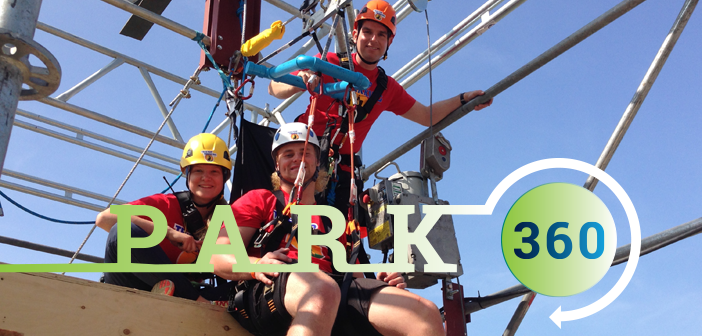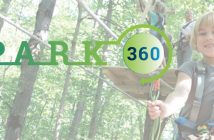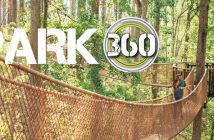Zip lines and tours across North America are developing methods to address issues of accessibility. More than 6.8 million Americans—not including those in assisted-living situations—use assistive devices (wheelchairs, motorized scooters, walkers, and canes) to help them with mobility. Those numbers are growing, and at a faster rate than the overall population, for several reasons—an aging population and increasing survival rates from traumatic injuries among them.
Accessible access is not usually required for zip lines, of course. Bill Botten of the U.S. Access Board, a federal agency that leads the development of accessibility guidelines and standards, says that zip lines were not specifically addressed when standards were being developed for amusement rides in the early 2000s. That’s not surprising, as zip lines were rare at the time—the industry’s growth has happened since then. And since zip lines lack a conventional seat, many operators are granted an ADA waiver due to the nature of the activity.
However, some zip line operators are coming up with creative solutions for accessibility and not just accepting the ADA waiver. Here’s a look at a few (All of the following can accommodate able-bodied riders as well as those requiring accessibility modifications.)
Camp Twin Lakes
Camp Twin Lakes provides camps for kids with serious illnesses, disabilities, and other challenges. The organization was founded in 1991 and began serving campers in 1993 in Rutledge, Ga. The camp offers customized weeklong programs for different populations of campers, teaching them to overcome obstacles and boost their confidence and capabilities.
With those goals in mind, Camp Twin Lakes Rutledge worked with Signature Research, Inc., to develop a ropes course, zip lines, climbing wall, and a giant swing that are accessible to all campers.
“We want to be able to help every child adapt to the setting and be able to accomplish those challenges,” says Josh Cagliani, senior camp coordinator. “We also want to push them to think about what resources they have in front of them, and how those could help them accomplish the goals they want to reach, in the hopes that this philosophy will challenge them to do the same thing outside of camp.”
The ropes course has elements such as the tire traverse, earthquake bridge, and one of the camp’s several zip lines. Campers are encouraged to work through each of the elements under the supervision of trained staff. Specialized swing arms and zip lines are in place for staff to assist campers with transfers, if necessary.
The climbing wall has three climbing routes and an open back equipped with a stairwell to the top platform. Campers can reach the top of the wall using ascenders and other tools, or climb the stairs to the top platform and ride a 600-foot zip line over the lake the camp is located on.
Campers unable to make the climb due to mobility issues are assisted to the top platform using a 4 to 1 pulley system. They are hooked in from the ground and raised to the platform where staff members assist with the transfer onto the zip cable.
The zip lines at CTL Rutledge are set up on a hydraulic system that gives CTL staff the ability to lower campers to the ground or directly into their wheelchairs. At CTL Will-O-Way, another CTL campsite in Winder, Ga., campers can be hooked in from the landing point and be reverse-hauled to the starting platform. They can then either release themselves or have a CTL staff member release them down the cable.
Whatever the setup, it often provides a life-altering experience. “It’s more of an adventure and something you may not do on a regular basis,” says Cagliani. “Our campers make their way through the world and they’re looked at differently. CTL is one place they can come and truly spend a week of their lives as a kid. Giving them the opportunity to do something like a zip line or a ropes course triggers their independence to go through the roof.”
Treetop Trekking at the Pan Am and Para Pan Am Games
The Pan Am and Para Pan Am Games have similar goals of inclusion. The 2015 Games in Toronto featured a temporary, accessible zip line installation on the city’s waterfront. Ontario-based Treetop Trekking designed the zip to meet the Accessibility for Ontarians with Disabilities Act (AODA) standards.
Having an accessible zip line at the Games was a big deal. The event took place over a 38-day period, with more than 6,000 athletes representing 41 National Olympic Committees in the Americas.
The custom zip line featured two 400-foot long cables strung between scaffolding towers. To ride it, zippers needed the capacity to transfer themselves into a reclining chair, where they were secured into a sit harness designed by Fusion Climb. The harness featured a special brace, or spreader, to provide additional stability and eliminate the need to steer.
Once the rider was secured in the harness, Treetop Trekking staff used an electric hoist and pulley system designed by Caliber Engineering Corp. to raise participants up the 60-foot launch tower. Riders were then transferred to the zip cable and sent flying over the Toronto waterfront to the opposite landing tower. Once across, a second hoist system lowered riders back to the ground.
Mike Stiell of Treetop Trekking says the goal was to make the zip as accessible as possible for the greatest range of individuals. “We were able to provide the activity for many who wouldn’t be able to try it otherwise,” he says. “Some riders had no mobility, others were non-verbal. All finished with a giant smile and a few happy tears. For them to be able to experience a zip line is an amazing thing we were thrilled to be part of.” Plus, zip liners got to take home a memento of the experience courtesy of FotaFlo, which offered free photos to all.
Others with access challenges may get their chance with similar equipment: Treetop Trekking has a course in the works that may feature some of the accessible designs developed for Games.
Gatorland’s Gator Gauntlet
Gatorland, Fla., designed and built its zip course in 2011. As part of the permitting process, Gatorland owner Mark McHugh offered to do a feasibility study in partnership with Orlando Hospital and Outdoors Accessibility from Tallahassee to determine what could be done to increase the accessibility of the zip line.
“[Mark] loves a challenge. We had a conversation about how great it would be if we could figure this out,” says Mike Hileman, park director at Gatorland. “It took us a little while, but because of his tenacity we did it. We wanted to be able to provide this experience to everyone.”
After three years of testing prototypes and finally settling on a quality apparatus, the Gator Gauntlet finally opened in 2016. If the 350-foot zip line isn’t enough of an adrenaline rush, flying over a breeding marsh that’s home to 130 alligators surely ups the ante.
As with the Pan Am Games installation, riders must have enough strength and mobility to transfer into the harnessing chair, or have a caregiver provide assistance. The custom harness features a spacer bar that provides stability for riders with little mobility, eliminating the need to steer.
An accessible ramp leads to the launch deck, where riders are attached to a chain hoist that raises them out of the wheelchair. Staff members transfer the rider to the zip cable and, using a quick-release carabiner, send them zipping over the marsh to the landing platform on the other side. A polyurethane padded catch plug slows riders into the platform, from which a chain host lowers them into a waiting wheelchair.
It takes four staff members to manage the 20-minute adventure, but Hileman says it’s worth it. “The reaction is incredible and overwhelming. We had a mom break down in tears because she could tell her son that he gets to participate in the same activity that his brother was doing,” he says.
Those types of reactions show why accessible zip line (and ropes course) installations can make sense for select operators: They provide a thrilling accomplishment and lifelong memory for people with mobility limitations. As one camper at CTL Rutledge said, “I may not be able to walk, but I can fly.” Not many other businesses can bestow such a gift.






